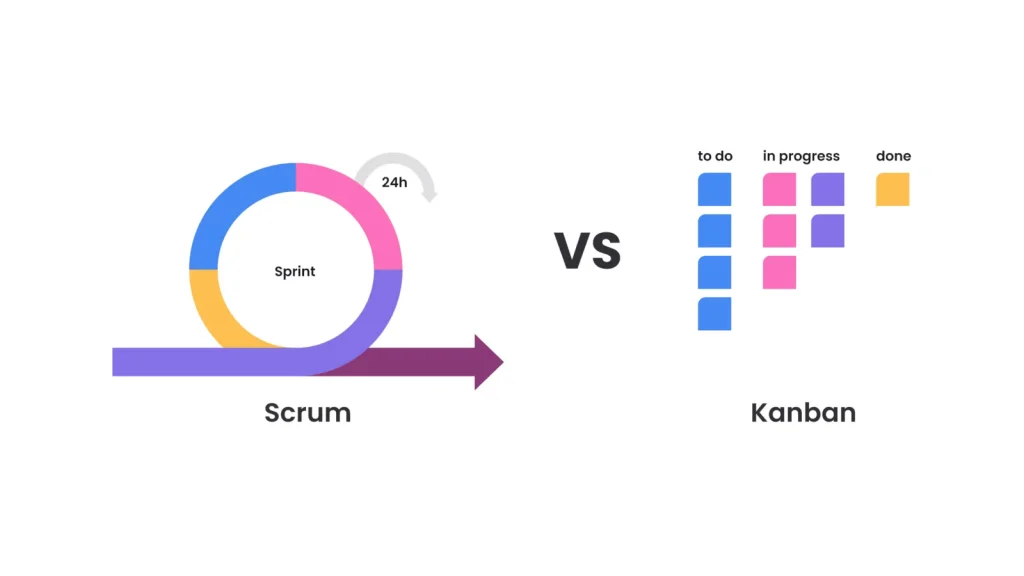SCRUM VS. KANBAN: WHAT ARE THE DIFFERENCES?
Have you ever heard “Kanban” and “Scrum” used synonymously? These are frequently mentioned in Agile methodologies. Although these two different development methodologies are sometimes confused (especially in our industry), they have very different implications. When you compare Kanban and Scrum, you’ll see how similar they are. Both frameworks are focused on iteratively enhancing a product by digging into how teams perform. However, there are a few distinctions. In this article, we’ll look at the key differences between Kanban and Scrum, including which method is better.
What is Kanban?
Kanban is an agile approach project management strategy. It’s a visual board where tasks are written down and then moved about as they’re completed. Taiichi Ohno, the father of Toyota’s production system, developed it.
Taiichi Ohno developed the Kanban technique to help Toyota’s manufacturing workers remember cheaper parts while work on vehicles. The technique grew popular among software development teams since it made them easier for them to manage their work and make quality improvement.
In both cases, the Kanban technique helps individuals in visualizing what is happening in their work so that potential issues can be identified before they become larger problems.
The four principles of the Kanban Method are given below:
1. Visualize the work
It provides a visual workflow model that helps in the analysis of the workflow as it comes through the Canban system.
2. Restrict the scope of the ongoing project
This allows team members to reduce the amount of time an item spends going through the Kanban system.
3. Pay close attention to the flow.
Using in-process work restrictions and setting team-focused rules, you can improve the Kanban system’s smooth workflow.
4.Ongoing Development
When the Kanban system is in place, it may be used to generate continuous improvement. Tracking team flow, quality delivery times, and other metrics allows them to analyze and measure their efforts.
What is Scrum?
Scrum is a project management technique that is used in the agile methodology. It helps by dividing the project into small chunks and then completing them one at a time. The Scrum technique divides the project into small chunks, which are called sprints. This helps in completing the project as quickly as possible without any interruption.
The Scrum technique has three roles:
1) The Product Owner: This individual decides what needs to be done next and assigns tasks to team members.
2) The Team: Tasks are assigned to the team members who are most qualified for those tasks based on their experience and skillset.
3) The Scrum Master: He/she makes sure that there is no confusion among team members, resolves conflicts, and keeps track of the time allotted for each task.
The Difference Between Scrum and Kanban
The Agile approach breaks the entire project into smaller modules, which makes it easier for the team to develop, test, and modify the product and, at last, to deliver a high-quality product. Kanban displays task workflows so the flow of tasks is optimized between different teams.
Kanban is a method of visualizing work as cards that are moved from column to column on a board. The kanban board shows what work needs to be done, by whom, and when it will be completed. In contrast, Scrum uses an iterative approach in which teams commit to delivering increments of functionality every sprint.
Which one is better: Scrum or Kanban?
Both Scrum and Kanban are effective project management methods. Both Scrum and Kanban provide the planning needed to make teams productive and successful. Scrum has a high level of commitment to the project. In Kanban, you keep things flexible by allowing your team to choose how to stay connected to the project.
If you’re wondering which of the two is better, we need to understand clearly what each method offers.
Scrum is a framework for developing and maintaining complex products. This is based on a recursive and gradual approach to product development. A typical Scrum project consists of multiple sprint projects, each lasting from one week to one month, and each sprint cycle includes planning, development, and review activities. The main purpose of this methodology is to deliver high-quality software within a fixed period of time.
Kanban is a lean approach that aims to increase productivity and deliver value quickly. This is based on the idea of using visual boards to visualize the workflow and optimize processes. In Kanban, tasks are grouped into columns according to their status: “To do,” “to do,” or “done”. This allows us to optimize resource allocation and process flow by identifying blockages early.
Given all this, the answer to this question varies depending on you and your project. You can choose Kanban or Scrum techniques based on the size, requirements, and availability of your project. Both ways will provide you with a variety of conveniences while managing your project.
For detailed information about our services, you can contact us here.

